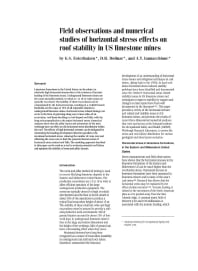Mining Publication: Field Observations and Numerical Studies of Horizontal Stress Effects on Roof Stability in U.S. Limestone Mines
Original creation date: June 2008
Authors: GS Esterhuizen, DR Dolinar, AT Iannacchione
NIOSHTIC2 Number: 20034729
J S Afr Inst Min Metall 2008 Jun; 108(6):345-352
Limestone formations in the United States can be subject to relatively high horizontal stresses due to the existence of tectonic loading of the limestone strata. Underground limestone mines use the room-and-pillar method, in which 12- to 18-m-wide rooms are typically excavated. The stability of these excavations can be compromised by the horizontal stress, resulting in a rockfall hazard. Rockfalls are the cause of 15% of all reportable injuries in underground limestone mines. Horizontal stress related damage can occur in the form of guttering along one or more sides of an excavation, roof beam buckling or oval shaped roof falls, with the long axis perpendicular to the major horizontal stress. Numerical analyses show that the pillar layout and orientation of the mine workings have an effect on the horizontal stress distribution within the roof. The effects of high horizontal stresses can be mitigated by orientating the heading development direction parallel to the maximum horizontal stress, reducing the number of cross-cuts and offsetting the cross-cuts to limit the potential lateral extent of horizontal stress related roof falls. The modeling approach described in this paper can be used as a tool to evaluate potential roof failure and optimize the stability of room and pillar layouts.

NIOSHTIC2 Number: 20034729
J S Afr Inst Min Metall 2008 Jun; 108(6):345-352
- Advance and Relieve Mining: A Method to Mitigate the Effects of High Horizontal Stress on the Mine Roof
- Analysis of Pillar Design Practices and Techniques for U.S. Limestone Mines
- Effect of the Dip and Excavation Orientation on Roof Stability in Moderately Dipping Stone Mine Workings
- Effects of Weak Bands on Pillar Stability in Stone Mines: Field Observations and Numerical Model Assessment
- Field Observations and Numerical Studies of Horizontal Stress Effects on Roof Stability in U.S. Limestone Mines
- Horizontal Stress
- In Situ Stress Measurements Near the Ross Shaft Pillar, Homestake Mine, South Dakota
- Investigation of Pillar-Roof Contact Failure in Northern Appalachian Stone Mine Workings
- Pillar Stability Issues Based on a Survey of Pillar Performance in Underground Limestone Mines
- Roof Stability Issues in Underground Limestone Mines in the United States